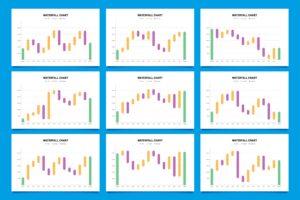The double bottom pattern is a strong technical analysis tool that signals a trend reversal from bearish to bullish. Recognizing this pattern early allows traders to capitalize on significant price movements. This detailed guide will help you understand, identify, and trade the double bottom pattern effectively.
Table of Contents
What is a Double Bottom?
It forms when an asset’s price declines, bounces back, and then drops again to the same support level before rising. This pattern resembles a “W” and indicates that sellers have lost control, making way for buyers.
Key Characteristics of a Double Bottom
First Bottom: The price falls to a significant support level.
Temporary Rebound: The price rises but struggles to break resistance.
Second Bottom: The price declines again, testing the previous low.
Breakout: The price surges above resistance, confirming a bullish trend.
Also Read: Trading for Beginners
How to Identify a Double Bottom Pattern?
Spotting this pattern requires careful observation of price movements and volume. Traders should follow these steps:
Step 1: Look for a Downtrend
It appears after a prolonged downtrend. If the market is sideways, the pattern is unreliable.
Step 2: Confirm Two Similar Lows
The second low should be near the first low, typically within a 3-4% range. A much lower second bottom might signal continued bearish pressure.
Step 3: Identify the Neckline
The highest price between the two lows forms the neckline, which acts as resistance. It is only confirmed when the price breaks above this level.
Step 4: Analyze Volume Movement
A strong breakout with high volume confirms the pattern. Weak volume increases the chance of failure.
Also Read: Fundamental Analysis
Why is the Double Bottom Pattern Important?
It is significant because it helps traders predict market movements and enter trades with confidence.
Predicting Trend Reversals
This pattern signals a shift from a bearish to a bullish market, helping traders anticipate upward momentum.
Better Entry and Exit Points
It allows traders to enter trades at the right moment and set accurate stop-loss levels.
Works Across Multiple Markets
Whether trading stocks, forex, or cryptocurrencies, it is applicable across various asset classes.
Also Read: Options Trading
Best Trading Strategies for a Double Bottom
Using it effectively can significantly boost profitability. Below are key strategies to trade this pattern.
Entry Strategy: Breakout Confirmation
Traders should enter a trade only when the price breaks above the neckline. A confirmed breakout reduces false signals.
Stop-Loss Placement: Managing Risk
Setting a stop-loss slightly below the second low minimizes potential losses if the pattern fails.
Profit Target Calculation
Measure the distance from the lowest point to the neckline, then project that distance upwards from the breakout point to set an accurate profit target.
Also Read: Positional Trading
How to Differentiate Between a Real and False Double Bottom?
This pattern does not always result in a bullish reversal. Here are ways to distinguish real from false patterns.
Check Volume at Breakout
A genuine pattern shows high volume at the breakout. Low volume suggests a potential false breakout.
Observe the Market Context
If the overall market remains bearish, even a confirmed double bottom may fail.
Use Additional Technical Indicators
Indicators like the Relative Strength Index (RSI) or Moving Averages help confirm its validity.
Also Read: Swing Trading
Real-Life Examples of the Double Bottom Pattern
Understanding how it works in real markets can help traders apply it effectively.
Example 1: Apple Stock in 2022
The stock dropped to $130, then bounced to $150.
It retested $130 but did not fall further.
A breakout above $150 led to a strong rally to $180.
Example 2: Bitcoin’s 2019 Recovery
Bitcoin fell to $3,500 before bouncing to $5,000.
It dropped again to $3,500, forming a double bottom.
A breakout led to a bullish rally past $10,000.
Also Read: Hedging
Common Mistakes to Avoid When Trading a Double Bottom
Avoiding these mistakes can improve your success rate when trading it.
Mistake 1: Entering Before Confirmation
It should only be traded after a confirmed breakout. Entering too early increases risk.
Mistake 2: Ignoring Volume Indicators
Weak volume at the breakout level often leads to failed patterns.
Mistake 3: Misidentifying the Pattern
Not all “W” shapes form valid double bottoms. Always confirm key characteristics before trading.
Also Read: Color Trading
Double Bottom vs. Double Top: Key Differences
A double bottom and a double top are opposite patterns.
Double Bottom: Bullish Reversal
Appears after a downtrend.
Indicates a shift to an uptrend.
Resembles a “W” shape.
Double Top: Bearish Reversal
Appears after an uptrend.
Signals a shift to a downtrend.
Resembles an “M” shape.
Also Read: Candlestick Trading
How to Use Technical Indicators with a Double Bottom?
Traders can enhance accuracy by combining it with technical indicators.
Moving Averages for Trend Confirmation
If the price crosses above the 50-day or 200-day moving average, the double bottom signal becomes stronger.
Relative Strength Index (RSI) for Overbought/Oversold Levels
An RSI below 30 before the pattern forms strengthens the reversal signal.
MACD for Momentum Confirmation
A bullish MACD crossover near the second bottom adds confirmation to the pattern.
Also Read: ETFs
FAQs on Double Bottom
1. How Reliable is a Double Bottom?
It is highly reliable, but it requires confirmation with volume and a breakout.
2. What Timeframe is Best for a Double Bottom?
Larger timeframes, like daily or weekly charts, provide stronger double bottom signals than shorter timeframes.
3. Can a Double Bottom Fail?
Yes, if the breakout lacks volume or market conditions are weak, the pattern may fail.
4. How Long Does a Double Bottom Take to Form?
It varies, but the pattern typically develops over weeks or months on larger timeframes.
5. What Happens After a Failed Double Bottom?
If the price breaks below support instead of rising, a continued downtrend is likely.
Also Read: Sector Rotation
Conclusion
This pattern is a reliable method for spotting bullish reversals. Traders who understand its structure, confirm signals, and apply the right strategies can increase profitability. However, risk management remains crucial. Always use stop-losses and volume confirmation before entering trades. By mastering this pattern, traders can identify hidden goldmines in financial markets.







